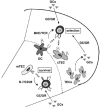Glucocorticoids in T cell apoptosis and function
- PMID: 16314919
- PMCID: PMC2792342
- DOI: 10.1007/s00018-005-5390-y
Glucocorticoids in T cell apoptosis and function
Abstract
Glucocorticoids (GCs) are a class of steroid hormones which regulate a variety of essential biological functions. The profound anti-inflammatory and immunosuppressive activity of synthetic GCs, combined with their power to induce lymphocyte apoptosis place them among the most commonly prescribed drugs worldwide. Endogenous GCs also exert a wide range of immunomodulatory activities, including the control of T cell homeostasis. Most, if not all of these effects are mediated through the glucocorticoid receptor, a member of the nuclear receptor superfamily. However, the signaling pathways and their cell type specificity remain poorly defined. In this review, we summarize our present knowledge on GC action, the mechanisms employed to induce apoptosis and the currently discussed models of how they may participate in thymocyte development. Although our knowledge in this field has substantially increased during recent years, we are still far from a comprehensive picture of the role that GCs play in T lymphocytes.
Figures




Similar articles
-
Local glucocorticoid production in lymphoid organs of mice and birds: Functions in lymphocyte development.Horm Behav. 2017 Feb;88:4-14. doi: 10.1016/j.yhbeh.2016.10.022. Epub 2016 Nov 3. Horm Behav. 2017. PMID: 27818220 Review.
-
Local glucocorticoid production in the thymus.Steroids. 2015 Nov;103:58-63. doi: 10.1016/j.steroids.2015.06.010. Epub 2015 Jun 20. Steroids. 2015. PMID: 26102271 Review.
-
Effects of altered glucocorticoid sensitivity in the T cell lineage on thymocyte and T cell homeostasis.FASEB J. 2002 May;16(7):727-9. doi: 10.1096/fj.01-0891fje. Epub 2002 Mar 26. FASEB J. 2002. PMID: 11923224
-
Lymphoid organs of neonatal and adult mice preferentially produce active glucocorticoids from metabolites, not precursors.Brain Behav Immun. 2016 Oct;57:271-281. doi: 10.1016/j.bbi.2016.05.003. Epub 2016 May 7. Brain Behav Immun. 2016. PMID: 27165988
-
Glucocorticoids and thymocyte development.Semin Immunol. 2000 Oct;12(5):475-85. doi: 10.1006/smim.2000.0265. Semin Immunol. 2000. PMID: 11085180 Review. No abstract available.
Cited by
-
Cushing syndrome and glucocorticoids: T-cell lymphopenia, apoptosis, and rescue by IL-21.J Allergy Clin Immunol. 2022 Jan;149(1):302-314. doi: 10.1016/j.jaci.2021.05.031. Epub 2021 Jun 2. J Allergy Clin Immunol. 2022. PMID: 34089750 Free PMC article.
-
Effects of glucocorticoids on leukocytes: Genomic and non-genomic mechanisms.World J Clin Cases. 2022 Jul 26;10(21):7187-7194. doi: 10.12998/wjcc.v10.i21.7187. World J Clin Cases. 2022. PMID: 36158016 Free PMC article. Review.
-
The progestin-only contraceptive medroxyprogesterone acetate, but not norethisterone acetate, enhances HIV-1 Vpr-mediated apoptosis in human CD4+ T cells through the glucocorticoid receptor.PLoS One. 2013 May 3;8(5):e62895. doi: 10.1371/journal.pone.0062895. Print 2013. PLoS One. 2013. PMID: 23658782 Free PMC article.
-
Histoplasma capsulatum, lung infection and immunity.Future Microbiol. 2015;10(6):967-75. doi: 10.2217/fmb.15.25. Future Microbiol. 2015. PMID: 26059620 Free PMC article. Review.
-
Hypothalamic-Pituitary-Adrenal Hormones Impair Pig Fertilization and Preimplantation Embryo Development via Inducing Oviductal Epithelial Apoptosis: An In Vitro Study.Cells. 2022 Dec 2;11(23):3891. doi: 10.3390/cells11233891. Cells. 2022. PMID: 36497149 Free PMC article.
References
-
- Bevan M. J. In thymic selection, peptide diversity gives and takes away. Immunity. 1997;7:175–178. - PubMed
-
- Budd R. C. Activation-induced cell death. Curr. Opin. Immunol. 2001;13:356–362. - PubMed
-
- Opferman J T., Korsmeyer S. J. Apoptosis in the development and maintenance of the immune system. Nat. Immunol. 2003;4:410–415. - PubMed
-
- Tuckermann J. P., Kleiman A., McPherson K. G., Reichardt H. M. Molecular mechanisms of glucocorticoids in the control of inflammation and lymphocyte apoptosis. Crit. Rev. Clin. Lab. Sci. 2005;42:71–104. - PubMed
Publication types
MeSH terms
Substances
LinkOut - more resources
Full Text Sources
Other Literature Sources
Medical
Miscellaneous

